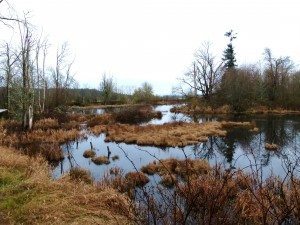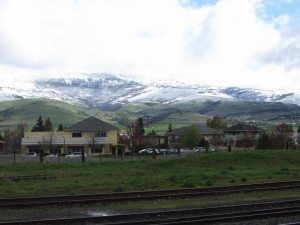Freeway Birding – SF to Seattle
By Sam Zuckerman
In the vast array of birding guides, it’s hard to stick out. Harry Fuller’s Freeway Birding: San Francisco to Seattle (Living Gold Press, 2013) distinguishes itself with a special hook. It only covers places to bird along the 800-mile Interstate 80 and I-5 corridor from San Francisco to Seattle. If a birding spot can’t be reached by taking a detour of 20 minutes or less, it’s not in the book.
Think of it as On the Road meets National Geographic Guide to Birding Hot Spots.
That’s precisely the book’s great virtue and weakness. The San Francisco-to-Seattle freeway route is certainly a rich birding area. As Fuller notes, fifteen National Wildlife Refuge units lie near the road, many of them wintering grounds for scores of migratory waterfowl species. Obviously though, some of the most spectacular birding destinations are outside the book’s geographical limit, including those along the Pacific coast and in the Sierra Nevada and Cascade Mountains.


Within the limits he’s set for himself, Fuller — a former Golden Gate Bird Alliance field trip leader who now lives in Oregon — does a workmanlike job of cataloging birding sites. He provides generally accurate information about refuges and parks, including driving directions for reaching them, what facilities are on site, what habitats are there, and a few of the species that can typically be found.
For some of the more important areas, such as the Sacramento National Wildlife Refuge, the descriptions are lengthy and detailed. In addition to sites that have been formally set aside as parks and protected areas, Fuller describes opportunities for birding at a few rest stops and side roads along the freeway.

Freeway Birding includes more than 100 maps of individual birding locales or the regions I-5 passes through. Although the book is not a field guide, it includes brief descriptions of a small number of species, including the Calliope Hummingbird, Wrentit, and Northern Spotted Owl. The book has some nice drawings, but no photos.
I have family in Seattle, and I travel there often. Generally I fly to Seattle so my I-5 birding experience has been limited to some of the California refuges north of Sacramento. I judged Freeway Birding by its descriptions of places I’m familiar with. These include East Bay birding sites, such as Tilden Park and the Albany mudflats, rural protected areas such as Colusa National Wildlife Refuge, and sites in and around Seattle.
Fuller’s descriptions of refuges and parks along the freeway outside metropolitan areas were generally helpful and sometimes extensive. But I found his information on Bay Area and Seattle-area sites unsatisfying. His directions were accurate, but the birding information was sketchy, limited to laundry lists of species typically found there.
It’s especially unfortunate that he doesn’t have more to say about Seattle birding. To my mind, that city is one of the great urban birding spots in the West. You can find Pileated Woodpeckers in Discovery Park, American Bittern in the Union Bay Natural Area (the Fill, to Seattleites), Bald Eagles along the Lake Washington shore, and Rhinoceros Auklets in Puget Sound. My brother, whose family includes two avid birders, even had a Snowy Owl land on his roof during one of the periodic irruptions of that extraordinary bird! Freeway Birding doesn’t do Seattle justice, disposing of the city in two-and-a-half pages. Discovery Park and the Fill aren’t even listed.
Nonetheless, this book will have value for some people. What Freeway Birding delivers is a compact package of information on a specific geographical slice of a three-state region. That’s a niche market, to be sure. But for a birder traveling through this territory who doesn’t want to haul multiple volumes, Fuller’s book may be useful.
Editor’s Note: Come hear Harry Fuller in person and buy a signed copy of Freeway Birding at our Speaker Series on Thursday evening Sept. 19th! Refreshments at 7 pm, program at 7:30. In Berkeley at Northbrae Community Chuch, 941 The Alameda (between Marin and Solano). Event is free for GGBA members, $5 for non-members. More info on our Speaker Series web page.
Harry Fuller will also be leading a GGBA birding trip to eastern Oregon in June 2014. For details, see our Travel with GGBA page.
————————
Golden Gate Bird Alliance member Sam Zuckerman has been a birder most of his adult life, when he can get away from his responsibilities as a journalist and writer. He is looking forward to getting out in the field more after he retires next year.
